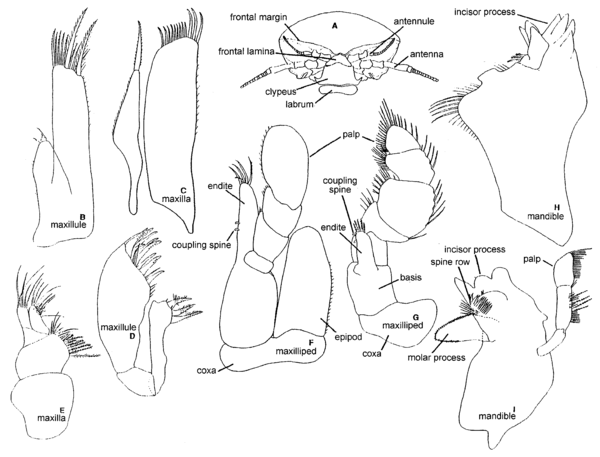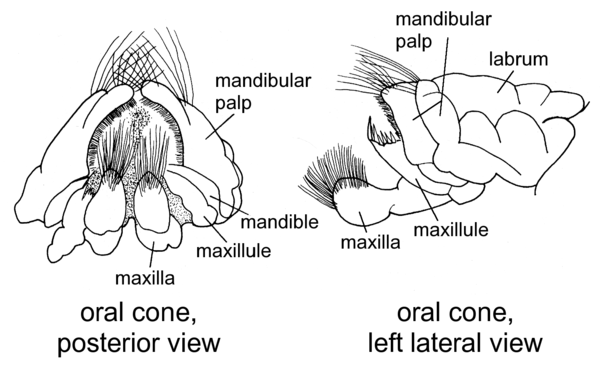- maxillule
- Cephalic appendages next behind mandible, serving as mouth part. (Syn. first maxilla, maxillula. In cirripeds, also termed inner maxilla) [Moore and McCormick, 1969].First maxilla; mouthparts immediately posterior to mandibles [Brusca and Brusca, 2002].One of a pair of the 4th cephalic appendages, usually serving as a mouthpart. (Syn. 1st maxilla) [McLaughlin, 1980].Second limb of cephalon, small and membranous. (Syn. maxilla 1) [Poore, 2004].Second pair of mouthparts (or fourth pair of appendages) [Ingle, 1983].(Order Cladocera):Fourth paired appendage of head. Consists of very small, simple, setae-bearing lobe. (absent, minute). (Syn. first maxilla) [Stachowitsch, 1992].(Order Notostraca):Fourth paired appendage of head; relatively small, located between mandibles and maxillae. Uniramous, simple, typically with spines along medial (inner) margin. (See also paragnath) [Stachowitsch, 1992].(Order Diplostraca):Fourth paired appendage of head; located between mandibles and maxillae. Relatively small, simple, setose lobe with small anterior accessory lobe. (Syn. first maxilla) [Stachowitsch, 1992].(Order Anostraca):Fourth paired appendage of head; located between mandibles and maxillae. Relatively small, uniramous, and typically bearing series of spines or setae along medial margin. (Syn. first maxilla) [Stachowitsch, 1992].(Class Cephalocarida):Fourth paired appendage of head (cephalon); located between mandibles and maxillae. Biramous, consisting of protopod (with large endite), annulate endopod, and one-segmented exopod. (Syn. first maxilla) [Stachowitsch, 1992].(Order Cumacea):Fourth paired appendage of head (cephalon); located between mandibles and maxillae. Represents second pair of mouthparts and consists of base (protopod) with two endites as well as distal palp (endopod). (Syn. first maxilla) [Stachowitsch, 1992].(Order Tanaidacea):Fourth paired appendage of head. Located between mandibles and maxillae; represents second pair of mouth-parts. If fully developed, consists of protopod bearing two endites as well as a palp (endopod). Mouthparts may be absent in male. (Syn. first maxilla) [Stachowitsch, 1992].(Order Decapoda):Second paired mouthpart on underside of head; borne on second cephalic segment (maxillular somite) and located between mandibles and maxillae. If fully developed, consists of protopod (with two endites), endopodal palp, and exile. (Syn. first maxilla) [Stachowitsch, 1992].(Order Amphipoda):Fourth paired appendage of head (cephalon); located between mandibles and maxillae. Represents second pair of mouthparts and, if fully developed, consists of base with two endites as well as distal palp. (Syn. first maxilla) [Stachowitsch, 1992].(Order Isopoda):Fourth pair of head appendages, functioning as mouthparts, immediately posterior to mandibles (= first maxillae). (Pl. maxillules) [Wetzer et al. 1997].(
 )Nomenclature of isopod cephalon (A). Examples of isopod mouth appendages: Idoteidae (B, C, F, H); Cirolanidae (D, E, G, I). [Wetzer et al. 1997](Order Isopoda):Fourth paired appendage of head (cephalon); located between mandibles and maxillae. Represents second pair of mouthparts and typically consists of base with two differently developed endites. (Syn. first maxilla) [Stachowitsch, 1992].(Order Mysida):Fourth paired appendage of head; located between mandibles and maxillae. Represents second pair of mouthparts. Consists of base bearing one or occasionally two endites, rarely also with endopod palp. (Syn. first maxilla) [Stachowitsch, 1992].(Order Stomatopoda):Second paired mouthpart on underside of head (cephalon); borne on fourth cephalic somite and located between mandibles and maxillae. Consists of two segments (coxa and basis, each with endite) and small endopod (palp). (Syn. first maxilla) [Stachowitsch, 1992].(Order Leptostraca):Fourth paired appendage of head (cephalon); located between mandibles and maxillae. Represents second pair of mouthparts and, if fully developed, consists of proximal section with two endites as well as distal palp. (Syn. first maxilla) [Stachowitsch, 1992].(Subclass Branchiura):Second paired mouthpart on underside of head (between mandibles and maxillae). Typically developed as prominent pair of suction discs, yet also as uniramous appendage with distal claws. (Syn. first maxilla) [Stachowitsch, 1992].(Subclass Cirripedia):(
)Nomenclature of isopod cephalon (A). Examples of isopod mouth appendages: Idoteidae (B, C, F, H); Cirolanidae (D, E, G, I). [Wetzer et al. 1997](Order Isopoda):Fourth paired appendage of head (cephalon); located between mandibles and maxillae. Represents second pair of mouthparts and typically consists of base with two differently developed endites. (Syn. first maxilla) [Stachowitsch, 1992].(Order Mysida):Fourth paired appendage of head; located between mandibles and maxillae. Represents second pair of mouthparts. Consists of base bearing one or occasionally two endites, rarely also with endopod palp. (Syn. first maxilla) [Stachowitsch, 1992].(Order Stomatopoda):Second paired mouthpart on underside of head (cephalon); borne on fourth cephalic somite and located between mandibles and maxillae. Consists of two segments (coxa and basis, each with endite) and small endopod (palp). (Syn. first maxilla) [Stachowitsch, 1992].(Order Leptostraca):Fourth paired appendage of head (cephalon); located between mandibles and maxillae. Represents second pair of mouthparts and, if fully developed, consists of proximal section with two endites as well as distal palp. (Syn. first maxilla) [Stachowitsch, 1992].(Subclass Branchiura):Second paired mouthpart on underside of head (between mandibles and maxillae). Typically developed as prominent pair of suction discs, yet also as uniramous appendage with distal claws. (Syn. first maxilla) [Stachowitsch, 1992].(Subclass Cirripedia):( ) [Anderson, 1980].Balanus trigonus: oral cone, posterior view; and oral cone, lefft lateral view. [Anderson, 1980](Subclass Cirripedia):Second paired mouth-part on head; located between mandibles and maxillae. Consists largely of gnathobase. (with/without notch) (see also oral pyramid). (Syn. first maxilla) [Stachowitsch, 1992].(Subclass Copepoda):The fourth cephalic appendage [Boxshall and Halsey, 2004].(Subclass Mystacocarida):Fourth paired appendage of cephalon; located between mandibles and maxillae. Uniramous, consisting of elongate protopod (with endites) and foursegmented shaft. Serves in locomotion and feeding. (Syn. first maxilla) [Stachowitsch, 1992].(Class Ostracoda):Fourth paired appendage of head; located posterior to mouth. Consists basically of proximal protopod with endites (masticatory processes) and variously developed distal branches (endopod, exopod). Serves, along with madibles, as masticatory appendage or is modified for locomotion. (Syn. first maxilla, maxilla) [Stachowitsch, 1992].(Class Ostracoda):Second paired mouthpart on underside of head; located between mandibles and maxillae. If fully developed, consists of proximal protopod with endites and exites as well as distal biramous palp with inner branch (endopod) and outer branch (exopod). The term first maxilla is often preferentially applied. (biramous, uniramous; setose, spinose, subchelate; prehensile). (Syn. first maxilla) [Stachowitsch, 1992].(Class Remipedia):Second paired mouthpart on underside of head (cephalon) between mandibles and maxillae. Uniramous, consisting of seven segments, and with main point of flexure between fourth and fifth segments. First four segments with endites, seventh with terminal talon, all with setae along inner margin. (prehensile, subchelate) [Stachowitsch, 1992].(Superorder Syncarida):Fourth paired appendage of head; located between mandibles and maxillae. Represents second pair of mouthparts. Bears two endites and, in anaspidacean, a small lobe (exite, also variously interpreted as endopod or exopod). (Syn. first maxilla) [Stachowitsch, 1992].(Order Thermosbaenacea):Fourth paired appendage of cephalon; located between mandibles and maxillae. Represents second pair of mouthparts. Consists of two-segmented protopod bearing two endites and small palp (endopod). (Syn. first maxilla) [Stachowitsch, 1992].(Order Euphausiacea):Fourth paired appendage of head (cephalon); located between mandibles and maxillae. Represents second pair of mouthparts and, if fully developed, consists of three-segmented base with two endites and one exile as well as distal endopod (palp). (foliaceous). (Syn. first maxilla) [Stachowitsch, 1992].
) [Anderson, 1980].Balanus trigonus: oral cone, posterior view; and oral cone, lefft lateral view. [Anderson, 1980](Subclass Cirripedia):Second paired mouth-part on head; located between mandibles and maxillae. Consists largely of gnathobase. (with/without notch) (see also oral pyramid). (Syn. first maxilla) [Stachowitsch, 1992].(Subclass Copepoda):The fourth cephalic appendage [Boxshall and Halsey, 2004].(Subclass Mystacocarida):Fourth paired appendage of cephalon; located between mandibles and maxillae. Uniramous, consisting of elongate protopod (with endites) and foursegmented shaft. Serves in locomotion and feeding. (Syn. first maxilla) [Stachowitsch, 1992].(Class Ostracoda):Fourth paired appendage of head; located posterior to mouth. Consists basically of proximal protopod with endites (masticatory processes) and variously developed distal branches (endopod, exopod). Serves, along with madibles, as masticatory appendage or is modified for locomotion. (Syn. first maxilla, maxilla) [Stachowitsch, 1992].(Class Ostracoda):Second paired mouthpart on underside of head; located between mandibles and maxillae. If fully developed, consists of proximal protopod with endites and exites as well as distal biramous palp with inner branch (endopod) and outer branch (exopod). The term first maxilla is often preferentially applied. (biramous, uniramous; setose, spinose, subchelate; prehensile). (Syn. first maxilla) [Stachowitsch, 1992].(Class Remipedia):Second paired mouthpart on underside of head (cephalon) between mandibles and maxillae. Uniramous, consisting of seven segments, and with main point of flexure between fourth and fifth segments. First four segments with endites, seventh with terminal talon, all with setae along inner margin. (prehensile, subchelate) [Stachowitsch, 1992].(Superorder Syncarida):Fourth paired appendage of head; located between mandibles and maxillae. Represents second pair of mouthparts. Bears two endites and, in anaspidacean, a small lobe (exite, also variously interpreted as endopod or exopod). (Syn. first maxilla) [Stachowitsch, 1992].(Order Thermosbaenacea):Fourth paired appendage of cephalon; located between mandibles and maxillae. Represents second pair of mouthparts. Consists of two-segmented protopod bearing two endites and small palp (endopod). (Syn. first maxilla) [Stachowitsch, 1992].(Order Euphausiacea):Fourth paired appendage of head (cephalon); located between mandibles and maxillae. Represents second pair of mouthparts and, if fully developed, consists of three-segmented base with two endites and one exile as well as distal endopod (palp). (foliaceous). (Syn. first maxilla) [Stachowitsch, 1992].
Crustacea glossary. Natural History Museum of Los Angeles County. 2011.
